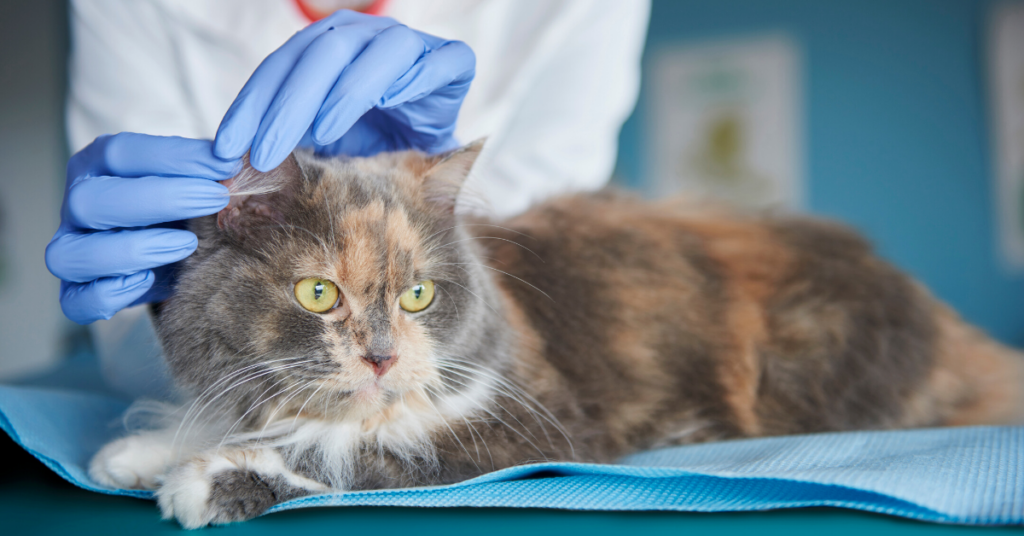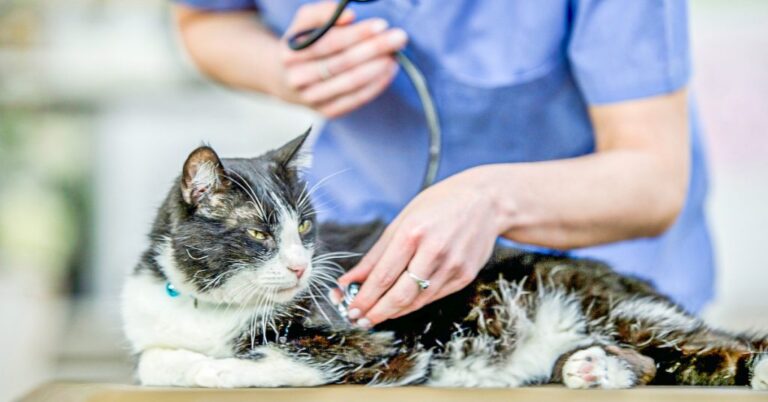Symptoms of Lymphoma in Cats
Reviewed by Erica L. Tramuta-Drobnis, VMD, MPH, CPH
Lymphoma in cats is a cancer of the lymphocytes, which are a type of white blood cells, that are part of the cat’s immune system.
Feline lymphoma is connected with feline leukemia, which is a viral infection. Lymphoma in cats is a common cancer, affecting 30% of the cats.
Read more to know what are the symptoms of lymphoma in cats; to help in early diagnosis and treatment of your feline friend.
What is Feline Lymphoma?

Feline lymphoma is a cancer that affects the lymphocytes and lymphatic system in cats.
The feline lymphatic system is a complicated network of components that transports life-sustaining chemicals throughout a cat’s body while also preventing the circulation of potentially harmful compounds.
The thymus gland, spleen, and bone marrow are among these components.
Lymphocytes have a variety of tasks in the immune system, including the creation of antibodies and other anti-infectious and anti-disease substances.
Cancer cells attack and destroy normal tissues in lymphoma. Lymphoma cells can grow everywhere in the cat’s body.
However certain areas are more often attacked by lymphoma than others (such as the GI tract, mediastinum, and lymph nodes). Lymphoma can spread to other organs in the body as the disease develops.
Forms of Lymphoma in Cats

There are various types of feline lymphoma. Tumors in all forms are made up of an abnormal growth of lymphoid tissue.
Lymphoma may appear anywhere in the cat’s body, and damage a wide range of organs since lymphocytes and lymph tissue are present throughout the body.
However, lymphoma is most often found in three areas of the body. The location is consistently related to the cause of the lymphoma.
Intestinal lymphoma: This is the most common type of lymphoma in cats, where it affects the gastrointestinal tract. It affects 50-70% of feline lymphoma cases, and most common in older cats.
Mediastinal lymphoma: This form of lymphoma affects the lymphoid organs in the chest such as the lymph nodes, or the thymus.
Young cats aged 5 years and older are usually affected by this type of lymphoma, and it’s strongly linked with feline leukemia virus.
Renal lymphoma: This form of lymphoma affects the kidneys, where functional kidney cells are replaced by cancer cells.
It’s linked to feline leukemia as well, where 50% of infected cats tested positive for feline leukemia.
Renal lymphoma has a very poor prognosis. The average survival time with this type of lymphoma is only 3-6 months.
Symptoms of Lymphoma in Cats

Symptoms of lymphoma in cats depend on the location of the lymphoma. The most common type is the intestinal lymphoma.
Intestinal lymphoma has signs similar to other intestinal diseases. Signs include weight loss, vomiting, and diarrhea.
Appetite, on the other hand, can vary; some cats have a decreased appetite, while others have an increased appetite, and other cats have no change in appetite.
Mediastinal lymphoma affects the chest, therefore has signs related to respiratory difficulties.
Fluid usually builds up around the tumor, making it more difficult for a cat to properly breathe.
Renal lymphoma has signs similar to kidney failure such as decreased appetite, weight loss, increased thirst, and vomiting.
These signs are caused by a buildup of toxins in the bloodstream, which the kidneys are unable to effectively filter outside the blood system.
Diagnosis of Lymphoma in Cats

In order to diagnose lymphoma in cats, your vet will have to find malignant cells on a microscopic inspection.
Before testing for lymphoma, your veterinarian may also do baseline screening bloodwork to check your cat’s overall health and rule out other possible causes of your cat’s clinical symptoms.
In some cases, the vet will use a fine needle aspirate to detect feline lymphoma. The veterinarian will inject a needle into an area of concern; an enlarged lymph node, an enlarged kidney, a thicker part of the gut, or fluid in the chest and remove a tiny number of cells.
These cells will next be inspected under a microscope for cancer cells. Although obtaining a high-quality diagnostic sample through aspirate is not always achievable, many veterinarians begin with this test since it has less risks, side effects, and expenses than surgical biopsy.
If a small needle aspirate is inconclusive or impossible due to the location of the tumor, your veterinarian may recommend a surgical biopsy instead. This entails removing a portion of tissue from the tumor.
This sample will then be processed and examined under a microscope to look for lymphoma.
If lymphoma is discovered by a biopsy, the pathologist can identify whether your cat has high-grade or low-grade lymphoma.
This is based on how quickly the cancer cells appear to divide and how malignant the cells appear to be.
High-grade lymphoma is more aggressive and malignant. Low-grade lymphoma is more likely to respond to chemotherapy, and treatment frequently results in extended durations of recovery.
Treatment of Lymphoma in Cats

Chemotherapy is usually used to treat lymphoma. In most cases, chemotherapy will extend the quantity and quality of life for your cat.
A variety of injectable chemotherapy agents are used to treat high-grade lymphoma.
Cats can handle chemotherapy far better than people; they rarely lose hair or seem ill. The most frequent side effects include nausea, diarrhea, and a loss of appetite. Even yet, only around 10% of cats have these symptoms.
Surgery and/or radiation therapy may be needed for lymphoma that is confined in one area, such as nasal tumors or abdominal masses, but this is uncommon.
However, the majority of cases are untreatable with surgery or radiation and will need chemotherapy.
If chemotherapy is not an option, because of the cat’s other health issues, or the owner’s financial situation. The vet may prescribe prednisone, which will offer a temporary reduction in clinical signs.
Finally, although lymphoma cannot be prevented, the chance of a cat developing lymphoma can be reduced by avoiding feline leukemia virus infection.
To avoid feline leukemia infection, all cats that go outside or whose owners take in strays with unknown feline leukemia status should be vaccinated against this virus.
When to See a Veterinarian

If you suspect your cat has lymphoma, or notice signs like weight loss, vomiting, diarrhea, or difficulty breathing, it’s best to call your veterinarian.
Your veterinarian will help check the overall health of your cat, identify if lymphoma is present, and recommend a treatment plan.







